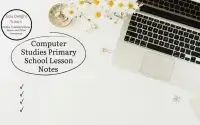Welcome Test Computer Studies Primary 2 Second Term Lesson Notes Week 1
Lesson Plan: Readiness Test – Computer Studies (Primary 2)
Second Term, Week 1
Subject: Computer Studies
Class: Primary 2
Term: Second Term
Week: 1
Age: 7-8 years
Topic: Readiness Test
Sub-topic: Introduction to Basic Computer Concepts
Duration: 40 minutes
Behavioral Objectives
By the end of the lesson, students should be able to:
- Identify basic computer parts.
- Explain simple uses of a computer in daily life.
- Demonstrate readiness to use computers with basic instructions.
Keywords
- Computer
- Mouse
- Keyboard
- Monitor
- CPU
- Software
- Hardware
Set Induction
Start by asking the students what they know about computers. Show pictures of different computer parts (keyboard, mouse, monitor, CPU) and ask them to name each part. Introduce the importance of computers in everyday life (e.g., for schoolwork, games, and communication).
Entry Behavior
Students should have prior knowledge of basic items in their environment, such as a television or radio. If they have seen or used a computer before, they might recognize some computer parts or know its uses.
Learning Resources and Materials
- Pictures of computer parts (monitor, keyboard, mouse, CPU)
- Simple diagram of a computer system
- Computer software for interactive learning
- Chalkboard or whiteboard
Building Background/Connection to Prior Knowledge
Most students have encountered basic technology like mobile phones, TVs, or radios. This lesson will connect those experiences to learning about computers, focusing on their basic parts and functions.
Embedded Core Skills
- Critical Thinking: Identifying and explaining the functions of computer parts.
- Problem Solving: Asking students to match parts to their functions.
- Communication: Discussing the uses of computers in daily life.
Learning Materials
- Flashcards with images of computer parts
- A toy or model computer to demonstrate the parts
- Projector or computer for showing examples (optional)
Reference Books
- Lagos State Scheme of Work for Computer Studies
- Primary 2 Computer Studies Curriculum Guide
- “Computer Basics for Kids” by K. Green
Instructional Materials
- Flashcards
- Diagram of a computer system
- PowerPoint slides or a projector for visual aid (optional)
Content
Definition of a Computer:
- A computer is an electronic device that processes information, stores data, and helps us complete various tasks.
Key Components of a Computer:
- Monitor: This is the screen where you see images, text, and videos.
- Keyboard: This is used to type letters, numbers, and symbols into the computer.
- Mouse: This is used to move the cursor on the screen and click on things.
- CPU (Central Processing Unit): This is the “brain” of the computer, where all instructions are processed.
- Software: Programs or applications that allow the computer to do different tasks (e.g., games, word processors).
- Hardware: The physical parts of a computer (e.g., keyboard, monitor, mouse).
Examples of Computer Uses:
- Typing assignments or letters.
- Playing educational games.
- Watching videos for learning.
- Drawing pictures using a program.
- Sending messages or emails.
Evaluation Questions
- A computer is an ____.
a) Animal
b) Device
c) Toy
d) Machine - The part of the computer that displays pictures and text is the ____.
a) Mouse
b) Keyboard
c) Monitor
d) CPU - You use a ____ to type letters and numbers into the computer.
a) Monitor
b) Keyboard
c) Mouse
d) CPU - The CPU is also known as the ____ of the computer.
a) Screen
b) Brain
c) Mouse
d) Keyboard - Which of these is not a part of the computer?
a) Monitor
b) Keyboard
c) Ball
d) Mouse - A computer is used to ____.
a) Play games
b) Eat food
c) Fly
d) Sleep - The CPU helps to ____ the computer.
a) Eat
b) Process information
c) Sing
d) Dance - A computer can help you ____ your homework.
a) Sing
b) Draw
c) Watch movies
d) Do - The ____ is used to move the cursor on the screen.
a) Keyboard
b) Mouse
c) CPU
d) Monitor - ____ is a program used to perform tasks on the computer.
a) Hardware
b) Software
c) Mouse
d) Keyboard - The keyboard is part of the ____ of the computer.
a) Hardware
b) Software
c) CPU
d) Mouse - A mouse is part of the ____ in a computer.
a) Screen
b) Hardware
c) Software
d) Programs - You use a ____ to play games on the computer.
a) Keyboard
b) Mouse
c) Monitor
d) CPU - Which of the following is used to write on the computer?
a) Mouse
b) Keyboard
c) Monitor
d) CPU - The part of the computer that makes things happen is called the ____.
a) CPU
b) Keyboard
c) Monitor
d) Mouse
Class Activity Discussion (FAQs)
- What is a computer used for?
A computer helps us do many things, like typing, playing games, and watching videos. - What is a monitor?
A monitor is the screen that shows everything you do on the computer. - What does a mouse do?
A mouse helps you move the cursor and click on things on the screen. - What is the CPU?
The CPU is the brain of the computer; it processes all the instructions. - What is software?
Software is a program that helps you do different things on the computer, like games or writing. - Can we touch a computer’s software?
No, software is not something we can touch; it is a program inside the computer. - Is a computer a type of machine?
Yes, a computer is a machine that helps us complete many tasks. - How does the keyboard help us?
The keyboard allows us to type words, numbers, and symbols. - Do all computers have the same parts?
Yes, most computers have the same basic parts, like the keyboard, mouse, monitor, and CPU. - What happens if the CPU breaks?
If the CPU breaks, the computer will not work properly because it processes all the information. - Can a computer be used for learning?
Yes, we can use a computer to learn by watching educational videos, playing games, and typing. - How does the mouse help me?
The mouse helps you select things and move around the screen. - What do we use the computer keyboard for?
We use the keyboard to type words and numbers. - Can we watch movies on a computer?
Yes, you can watch movies and videos on a computer. - Why is a computer important?
A computer is important because it helps us learn, communicate, and do many other tasks easily.
Presentation Structure
- Step 1: The teacher revises the previous lesson, if any.
- Step 2: The teacher introduces the new topic on computer parts and their functions.
- Step 3: The teacher encourages students to contribute their knowledge and corrects any mistakes.
Teacher’s Activities
- Show the flashcards of computer parts.
- Demonstrate how each part works (e.g., typing on the keyboard).
- Ask students to name the parts of a computer as you display them.
- Introduce examples of how computers are used.
Learners’ Activities
- Listen and observe the teacher’s demonstration.
- Answer questions about computer parts and their uses.
- Match images of computer parts to their functions.
- Participate in class discussions.
Assessment
- Name two parts of the computer.
- What does the keyboard do?
- Explain the role of the monitor.
- Describe the function of the CPU.
- Name a computer software you know.
- How do we use a mouse?
- What is a computer used for?
- List three parts of a computer.
- Why is the CPU important?
- How can we learn using a computer?
Conclusion
The teacher circulates around the class to mark students’ work and provide feedback. Encourage students to practice recognizing computer parts and their functions.
Related Posts
Third Term Promotional Examinations Primary 2 English Grammar


3RD TERM EXAM QUESTIONS PRIMARY 2 CIVIC EDUCATION


Exploring Different Ways to Turn Off Your Computer Primary 2 Third Term Lesson Notes Week 9 & 10
About The Author
Edu Delight Tutors
Am a dedicated educator with a passion for learning and a keen interest in technology. I believe that technology can revolutionize education and am committed to creating an online hub of knowledge, inspiration, and growth for both educators and students. Welcome to Edu Delight Tutors, where learning knows no boundaries.